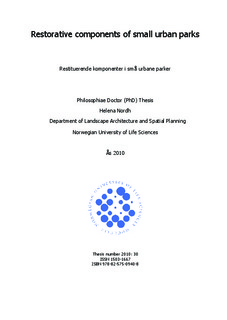| dc.contributor.advisor | Hägerhäll, Caroline | |
| dc.contributor.advisor | Hartig, Terry | |
| dc.contributor.advisor | Fry, Gary | |
| dc.contributor.author | Nordh, Helena | |
| dc.date.accessioned | 2017-02-23T12:59:12Z | |
| dc.date.available | 2017-02-23T12:59:12Z | |
| dc.date.issued | 2010 | |
| dc.identifier.isbn | 978-82-575-0940-8 | |
| dc.identifier.issn | 1503-1667 | |
| dc.identifier.uri | http://hdl.handle.net/11250/2431920 | |
| dc.description.abstract | The growing body of knowledge about restorative environments shows that nature offers a restorative advantage over common outdoor urban public spaces with regard to recovery from attentional fatigue and stress. There is however a lack of research on the environmental components in natural environments that promote restoration. This detailed knowledge is important to landscape architects, who have a professional responsibility for the development of green structure in cities. The need for this information is perhaps even more important today, as the trend in European city planning is densification. This pattern of urban development is sometimes created at the cost of urban parks. In light of the densification process, this thesis is about the environmental components in small urban Scandinavian parks (pocket parks) that can support restorative experiences for people living and working in an urban setting. The environmental components under study are: hardscape, grass, lower ground vegetation, flowering plants, bushes, trees, water, and park size. Other people in the park are also of interest as a social component. The empirical research presented in this thesis is based on three different methods: photo ratings with regression analysis, photo ratings with eye tracking analysis and a questionnaire with choice-based conjoint analysis. With this battery of methods the ambition was to demonstrate the potential of quantitative methods that have previously been little used in landscape architecture. The respective strengths and weaknesses of the different methods are addressed in the thesis. The results from the studies converge in showing that people will assign high likelihoods of restoration to even small urban parks. All environmental components except for hardscape contributed to perceived likelihood of restoration. However, the components most important for these judgments were grass and trees. This result is in conflict with the common trend in Scandinavia, where use of hard paving materials such as concrete or granite is growing. Trees and grass take a relatively long time to establish compared to decorative components such as water features and flowers, hence, their use requires long term planning. To conclude, vegetation and in particular trees and grass are important components in small urban parks with regard to anticipated restoration. Despite a restricted park size and the presence of a moderate number of other people small parks can with the right design function as restorative spaces, hence in a longer perspective contribute to public health. | nb_NO |
| dc.description.abstract | Den stadig økende kunnskapen om restituerende miljøer viser at natur gir bedre mulighet til å innhente seg fra mental utmattelse og stress enn det urbane miljøer gir. Det finnes imidlertid mindre forskning om hvilke komponenter i naturlige miljøer som fremmer slik restitusjon. Denne detaljerte informasjonen er viktig for landskapsarkitekter som har et profesjonelt ansvar for utvikling av grønnstruktur i byer. Behovet for slik informasjon er kanskje enda viktigere i dag, ettersom fortetting er trenden innen europeisk byplanlegging. Fortetting skjer ofte på bekostning av byparker. I lys av fortetningsprosessen undersøkes det i denne avhandlingen hvilke komponenter i små, urbane, skandinaviske parker som fremmer en restituerende opplevelse for mennesker som bor og jobber i byer. De fysiske komponentene som har blitt studert er; harde overflater, gress, lav markvegetasjon, busker, trær, vann og parkstørrelse. Antall personer som er tilstede i parken er også interessant som en sosial komponent. Den empiriske forskningen som presenteres i avhandlingen er basert på tre ulike metoder, vurdering av parkbilder med regresjonsanalyse, vurdering av parkbilder med øyebevegelsesanalyse og internett-basert spørreundersøkelse med choice based conjoint analyse. Med disse ulike metodene var ambisjonen å demonstrere hvordan relativt nye kvantitative metoder innen landskapsarkitektur kunne bidra med verdifull informasjon til denne typen forskning. Metodenes respektive styrker og svakheter er diskutert i avhandlingen. Resultatene fra studiene konvergerer med hensyn på små parkers evne til å muliggjøre restitusjon. Alle komponenter, unntatt hard overflate, bidro til oppfattet mulighet til restitusjon. De komponentene som var viktigst var gress og trær. Dette resultatet er i konflikt med den utviklingen man ser i Skandinavia i dag, der bruken av harde materialer som betong og granitt er økende. Trær og gress tar relativt lang tid å etablere sammenliknet med vannelementer og blomster, hvilket innebærer at langsiktig planlegging blir enda viktigere. Konklusjonen er at vegetasjon, og spesielt trær og gress, er viktige komponenter i urbane småparker. Til tross for parkenes begrensede størrelse, og tilstedeværelse av et begrenset antall andre mennesker, kan disse parkene, med rett design, fungere som steder for restitusjon og dermed være fremmende for folkehelse i et langsiktig perspektiv. | nb_NO |
| dc.language.iso | eng | nb_NO |
| dc.publisher | Norwegian University of Life Sciences, Ås | nb_NO |
| dc.relation.ispartofseries | PhD Thesis;2010:30 | |
| dc.rights | Attribution-NonCommercial-NoDerivatives 4.0 Internasjonal | * |
| dc.rights.uri | http://creativecommons.org/licenses/by-nc-nd/4.0/deed.no | * |
| dc.title | Restorative components of small urban parks | nb_NO |
| dc.title.alternative | Restituerende komponenter i små urbane parker | nb_NO |
| dc.type | Doctoral thesis | nb_NO |
| dc.subject.nsi | VDP::Social science: 200::Urbanism and physical planning: 230 | nb_NO |
| dc.source.pagenumber | 1 b. (flere pag.) | nb_NO |

